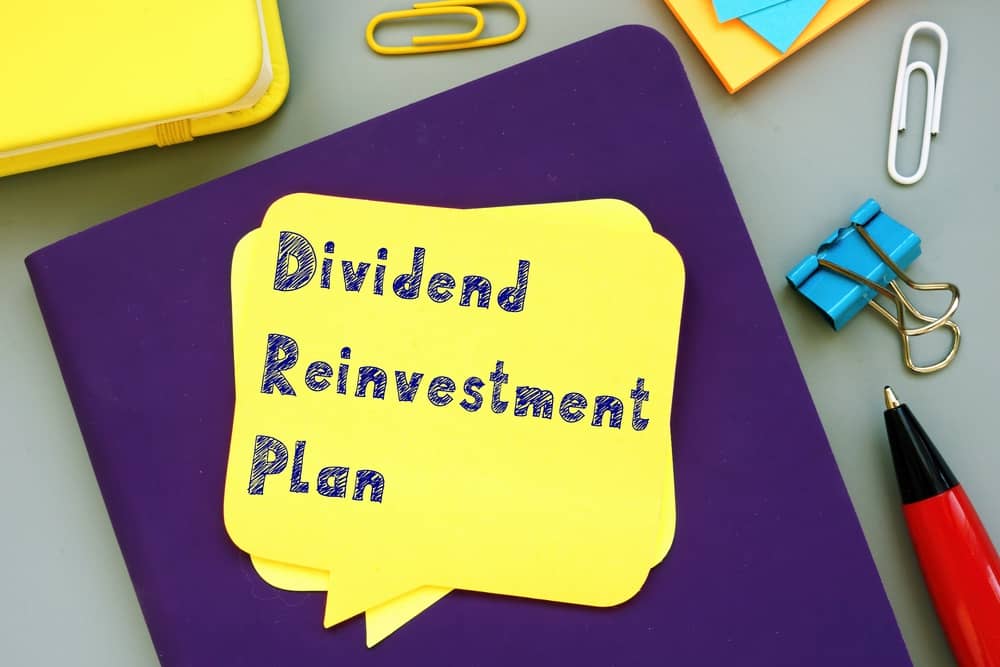If you’re looking to make the most of your investments, dividend reinvestment with Fidelity can be a valuable strategy. By reinvesting your dividends, you can maximize the growth potential of your portfolio and potentially increase your dividend income over time.
Disclaimer: This information is general in nature and for informational purposes only. It is not personal financial advice and has not taken into account your personal financial position or objectives. Make sure to refer to a licensed financial or tax advisor.
By default, Fidelity deposits any dividends you receive as cash into your Fidelity Account®. However, you have the option to choose dividend reinvestment instead. It’s easy to update this option and start reinvesting your dividends. Simply log in to your individual account on Fidelity.com and select “Account Features” from the “Accounts & Trade” tab. Then, choose “Dividends and Capital Gains” under “Brokerage & Trading Accounts & Trade” and select “Reinvest in Security” to automatically purchase additional stock with your dividends.
Fidelity Stock Plan Services provides recordkeeping and administrative services for your company’s equity compensation plan, and you can reach out to them for any questions or assistance you may need. Remember, investing involves risk, so it’s important to be informed and open your Fidelity account to avoid additional tax withholding on certain transactions.
Table of Contents
Key Takeaways:
- Dividend reinvestment with Fidelity allows you to maximize the growth potential of your portfolio.
- By choosing to reinvest your dividends, you can increase your holdings of company stock and potentially benefit from compounding returns over time.
- To start reinvesting your dividends with Fidelity, log in to your individual account on Fidelity.com and update your preferences under “Dividends and Capital Gains”.
- Fidelity Stock Plan Services can provide assistance with your company’s equity compensation plan.
- Remember to review the risks and consult relevant investment documents before making any investment decisions.
Understanding Dividend Reinvestment Plans (DRIPs)
Dividend reinvestment plans, also known as DRIPs, allow investors to automatically use their dividends to purchase additional shares of the issuing security. While most mutual funds offer DRIPs, dividend reinvestment for some ETFs may need to be done manually. However, Fidelity offers options for both automatic and manual dividend reinvestment.
Automatic dividend reinvestment plans directly from the fund sponsor may not be available for all ETFs, but Fidelity allows you to set up a DRIP for any ETF that pays dividends. Automatic dividend reinvestment can be convenient, but it may limit your ability to time the market. On the other hand, manual dividend reinvestment provides more control but may be less convenient.
If your brokerage firm does not provide a DRIP option or if the ETFs you’re invested in don’t allow for automatic reinvestment, you can reinvest dividends manually by using the cash received from dividend payments to buy more shares of the ETF. Keep in mind that settlement delays and fluctuations in market prices can affect the number of shares you can purchase through manual reinvestment.
| Automatic Dividend Reinvestment | Manual Dividend Reinvestment |
|---|---|
| Convenient, no need for manual action | Provides more control over timing |
| May limit ability to time the market | Requires active management |
| Available for most mutual funds, limited availability for some ETFs | Can be done for any ETF that pays dividends |
Manual Dividend Reinvestment with Fidelity
If your brokerage firm does not offer a DRIP option or if the ETFs you’re invested in don’t allow for automatic reinvestment, you can still manually reinvest dividends with Fidelity. Manual reinvestment involves taking the cash earned from a dividend payment and executing an additional trade to buy more shares of the ETF.
Depending on your investment account, you may incur commission charges for these trades, although some brokerage firms offer commission-free dividend reinvestments. Manual reinvestment provides you with greater control over your trades, allowing you to time your reinvestment based on market conditions.
You can choose to wait to reinvest if you believe the share price may drop or hold your dividends in cash if you want to invest elsewhere. However, it’s important to be aware of settlement delays for ETF dividends, as they typically take longer to settle compared to mutual funds. This can impact the buying power of your dividends and may result in higher prices per share if the ETF is performing well.
Manual Dividend Reinvestment Steps
| Step | Actions |
|---|---|
| 1 | Receive dividend payment |
| 2 | Transfer cash to brokerage account |
| 3 | Place a trade to buy more shares of the ETF |
| 4 | Monitor market conditions and choose the optimal time to reinvest |
Key Considerations for Dividend Reinvestment with Fidelity
When it comes to dividend reinvestment with Fidelity, there are several key factors that you should consider. These considerations will help you make informed decisions and ensure that your dividend reinvestment strategy aligns with your overall investment goals.
Determine the Reinvestment Method
Review your Fidelity account and determine whether the ETFs you’re invested in allow for automatic dividend reinvestment or if you need to reinvest manually. Check with Fidelity or your brokerage firm for eligibility and the specific process for dividend reinvestment.
Control and Convenience Trade-Off
Consider the trade-off between automatic and manual reinvestment. Automatic reinvestment is a set-it-and-forget-it approach, while manual reinvestment provides more control. With automatic reinvestment, dividends are reinvested automatically, but you may lose the ability to time the market. With manual reinvestment, you have more control over when and how you reinvest, but it requires active management and may result in commission charges.
Evaluate Settlement Delays
Take into account the settlement delays for ETF dividends. Settlement delays can impact the timing and cost of your reinvestment. It’s important to understand how these delays may affect the buying power of your dividends and the potential impact on share prices if the ETF is performing well.
Assess Your Investment Strategy and Goals
It’s essential to assess your overall investment strategy and goals to determine if dividend reinvestment aligns with your long-term objectives. Consider the role that dividend income plays in your investment strategy and evaluate whether reinvesting dividends will help you maximize your portfolio’s growth potential.
By carefully considering these key factors, you can make informed decisions about dividend reinvestment with Fidelity and ensure that your strategy is tailored to your specific needs and objectives.
| Consideration | Description |
|---|---|
| Determine the Reinvestment Method | Review your account and determine if automatic or manual reinvestment is available for the ETFs you’re invested in. |
| Control and Convenience Trade-Off | Weigh the benefits of automatic reinvestment against the control offered by manual reinvestment. |
| Evaluate Settlement Delays | Understand the impact of settlement delays on the timing and cost of your reinvestment. |
| Assess Your Investment Strategy and Goals | Consider how dividend reinvestment aligns with your long-term investment objectives. |
Maximizing Your Portfolio Growth with Fidelity
Dividend reinvestment with Fidelity can help you maximize your portfolio’s growth potential. By reinvesting your dividends, you can increase your holdings of company stock and potentially benefit from compounding returns over time. This strategy is especially beneficial if you don’t need the cash flows generated from dividends for immediate income. By reinvesting your dividends, you can capitalize on the power of reinvestment and potentially generate even greater dividend income in the future.
Fidelity offers a range of services and resources to support dividend reinvestment, including their Dividend Reinvestment Program and dedicated Stock Plan Services representatives who can provide assistance and answer any questions you may have.
When you reinvest your dividends with Fidelity, you’re not only increasing your ownership in the company but also taking advantage of the potential growth opportunities presented by the stock. By continuously reinvesting your dividends, you can potentially access a larger pool of shares, which may result in higher future dividend payments and overall portfolio growth.
Fidelity’s Dividend Reinvestment Program allows you to seamlessly reinvest your dividends and avoid the hassle of manually reinvesting on your own. With this program, your dividends are automatically used to purchase additional shares of the stock at the market price.
By reinvesting your dividends, you can potentially benefit from the compounding effect over time. The more shares you own, the more dividends you can potentially receive and reinvest, leading to even more shares and more dividends. This cycle can help accelerate the growth of your portfolio and potentially generate a significant income stream.
The Benefits of Dividend Reinvestment with Fidelity:
- Maximize your portfolio’s growth potential
- Benefit from potential compounding returns
- Increase your holdings of company stock
- Potentially generate greater dividend income in the future
By taking advantage of Fidelity’s Dividend Reinvestment Program, you can optimize your portfolio’s growth trajectory and potentially achieve your long-term financial goals.
Exploring Fidelity Investment Options
When it comes to complementing your dividend reinvestment strategy, Fidelity offers a range of investment options to choose from. Their brokerage accounts grant you access to a variety of investment avenues, including stocks, options, ETFs, and even fractional shares. This allows you to build a diversified investment portfolio tailored to your needs and goals.
Fidelity also offers cash management accounts that provide the convenience of a traditional checking account, without the need for a bank. These accounts offer features such as check-writing privileges, debit cards, and ATM access, making it easy to manage your cash flow alongside your investment activities.
Investing involves risk, including the risk of loss.
In addition to brokerage and cash management accounts, Fidelity provides tax-advantaged saving options to help you grow your wealth. Health Savings Accounts (HSAs) allow you to save for medical expenses with pre-tax dollars, while 529 college savings plans enable you to save for education expenses while potentially enjoying tax advantages. These investment types offer unique benefits and considerations, and it’s important to evaluate them based on your personal financial goals.
Comparison Table: Fidelity Investment Options
| Investment Option | Features | Considerations |
|---|---|---|
| Brokerage Accounts | Access to stocks, options, ETFs, and fractional shares. Diversify your portfolio and trade on the stock market. | Requires active management and may have trading fees. |
| Cash Management Accounts | Features of a traditional checking account, including check-writing, debit cards, and ATM access. | No physical branches for in-person assistance. |
| Health Savings Accounts (HSAs) | Save for medical expenses with pre-tax dollars and potentially enjoy tax-free withdrawals for qualified medical expenses. | Must be eligible for a high-deductible health plan to contribute to an HSA. |
| 529 College Savings Plans | Save for education expenses with potential tax advantages. Choose from a range of investment options. | Contributions have limitations and there may be penalties for non-qualified withdrawals. |
By considering the advantages and considerations of each investment option, you can make informed decisions that align with your investment strategy. This will contribute to achieving your financial goals and maximizing the potential of your dividend reinvestment activities.
Risks and Disclosures
When it comes to investing and dividend reinvestment, there are inherent risks that you should be aware of. Investing in securities always carries the risk of loss, and the value of your investment can fluctuate over time. This means that you may end up gaining or losing money depending on market conditions. Additionally, dividend reinvestment may have tax implications, and it’s important to report any reinvested dividends on your tax returns.
Fidelity understands the importance of providing clear disclosures and important information to help you make informed investment decisions. It is crucial to carefully review the prospectus, offering circular, or summary prospectus for any investment you are considering. These documents will provide you with detailed information about the investment’s objectives, risks, and expenses.
Fidelity Dividend Reinvestment Services
“At Fidelity, we prioritize transparency and strive to provide our clients with the information they need to make sound investment decisions. Our team is dedicated to assisting you every step of the way, offering a range of services and resources to support your dividend reinvestment journey. From our Dividend Reinvestment Program to our knowledgeable Stock Plan Services representatives, we are here to help.”
Aside from providing essential disclosures, Fidelity offers a suite of services and resources to assist you with your investment questions and needs. Their Dividend Reinvestment Program allows you to easily reinvest your dividends and potentially maximize your investment returns. Whether you have inquiries about dividend reinvestment accounts or need guidance on the process, Fidelity’s dedicated Stock Plan Services representatives are available to provide assistance.
As you explore dividend reinvestment with Fidelity, keep in mind that investing involves risk and it’s important to have a comprehensive understanding of the risks and potential rewards. By being well-informed and taking advantage of the resources and services available to you, you can navigate the investment landscape with confidence.

How Does Dividend Reinvestment with M1 Finance Compare to Fidelity?
When it comes to dividend reinvesting with M1 Finance, investors can benefit from fractional shares and automated portfolio rebalancing. Fidelity also offers dividend reinvestment, but without the fractional shares feature. M1 Finance’s automated approach and flexibility make it a more appealing option for dividend reinvesting.
Conclusion
Dividend reinvestment with Fidelity can be a powerful tool for growing your portfolio and increasing your dividend income over time. By understanding the options and considerations for dividend reinvestment, you can make informed decisions that align with your investment goals and strategy.
Fidelity offers both automatic and manual dividend reinvestment options, allowing you to choose the approach that best suits your needs. Automatic reinvestment provides convenience and helps to maximize the power of compounding returns. Manual reinvestment, on the other hand, provides more control over your trades and allows for potential market timing.
It’s important to assess your overall investment strategy and carefully review the risks and disclosures associated with investing and dividend reinvestment. Investing in securities involves risk, and it’s crucial to be aware of the potential for loss. Fidelity provides a diverse range of investment options and resources to support your dividend reinvestment strategy.
With Fidelity’s reliable Dividend Reinvestment Plan and comprehensive Dividend Reinvestment Program, you can confidently navigate the world of dividend reinvestment and unlock the full potential of your investments. Start growing your portfolio and increasing your dividend income with Fidelity today!
FAQ
How can I reinvest dividends with Fidelity?
To reinvest dividends with Fidelity, log in to your individual account on Fidelity.com and select “Account Features” from the “Accounts & Trade” tab. Then, choose “Dividends and Capital Gains” under “Brokerage & Trading Accounts & Trade” and select “Reinvest in Security” to automatically purchase additional stock with the dividends.
Do all mutual funds offer dividend reinvestment plans (DRIPs)?
Yes, most mutual funds offer DRIPs. However, dividend reinvestment for some ETFs may need to be done manually. Fidelity offers options for both automatic and manual dividend reinvestment.
What if my brokerage firm does not offer a DRIP option or if the ETFs I’m invested in don’t allow for automatic reinvestment?
If your brokerage firm does not provide a DRIP option or if the ETFs you’re invested in don’t allow for automatic reinvestment, you can reinvest dividends manually by using the cash received from dividend payments to buy more shares of the ETF.
Are there settlement delays for ETF dividends?
Yes, settlement delays for ETF dividends can impact the buying power of your dividends and may result in higher prices per share if the ETF is performing well.
How do I choose between automatic and manual dividend reinvestment?
Consider the trade-off between control and convenience. Automatic reinvestment is set-it-and-forget-it, while manual reinvestment provides more control but requires active management and may result in commission charges.
What investment options does Fidelity offer?
Fidelity offers a range of investment options, including stocks, options, ETFs, and cash management accounts that provide the features of a traditional checking account without a bank.
What are the risks associated with dividend reinvestment?
Investing in securities involves risk, including the risk of loss. Additionally, dividend reinvestment may be subject to taxation, and it’s important to report reinvested dividends on your tax returns.
How can dividend reinvestment help maximize portfolio growth?
By reinvesting dividends, you can increase your holdings of company stock and potentially benefit from compounding returns over time, maximizing your portfolio’s growth potential.







